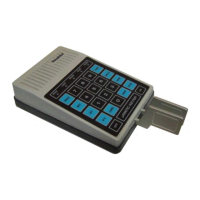- 2 -
INTRODUCTION
The SA-5010A µMatic Memory Keyer is a compact unit with modern design in electronics and
styling. The Memory Keyer uses a microprocessor which keeps component count low and reliability
high. Features of the Memory Keyer include:
1. Up to 10 buffers for storing text or commands. These are variable length buffers, which elimi-
nates wasted memory space. Available memory is also effectively increased by the use of
"command strings" and by a repeat feature which allows you to automatically send a message
up to ten times.
2. An editing feature which allows easy recovery from errors when you load a message buffer.
3. A built-in sidetone oscillator and speaker with variable volume and pitch. A phone jack and ear-
phone are provided for private use.
4. A thin 22-position keypad lets you select character formation, speed character spacing, charac-
ter weighting, message repeat count, buffer number and mode. The sidetone is gated to pro-
vide audible feedback to produce a "click". Illegal entries and error conditions produce a "war-
ble".
5. Integral capacitive "touch" paddles which reduce fatigue. The paddles unplug and store inside
the keyer when not in use. Also, a rear panel jack is provided for an external mechanical pad-
dle assembly.
6. Full "iambic" features.
7. Five LEDs to indicate the current mode of the keyer.
8. A "practice" mode which allows you to send random code groups of random length and se-
lectable types (alpha, alphanumeric and alphanumeric plus punctuation). 100 different repeat-
able random sequences are available, all of which are altered every time you turn on the keyer.
9. A P/C key which allows you to pause, manually insert text into a buffer message being sent
and then continue. When you insert a pause character in a message or command string, an
automatic pause is made at that point, so you can manually insert text.
10. CMOS memory with battery backup to retain the buffer contents, as well as the last-selected
speed, spacing, weight and repeat count while the keyer is turned off and unplugged.
11. Selection of either right-handed or left-handed operation from the keypad.
12. Built-in diagnostics that check the microprocessor each time the keyer is turned on and test
RAM when batteries are replaced or when the keyer is reset.
13. Automatic shutoff after more than approximately 15 minutes of non-use.

